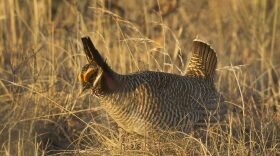Oklahoma State University has covered windows on two of its biggest buildings with polka dots.
Those adornments aren’t to make the buildings cuter — they’re to protect birds who might otherwise fly into the broad reflective surfaces.
Up to a billion birds die each year in the United States after flying into windows. Ecologist Scott Loss determined that number when he was studying bird mortality across the country at the Smithsonian Institute. Now, he’s a professor in OSU’s Department of Natural Resource Ecology and Management, and he’s working with a team of researchers to understand and prevent bird deaths on campus.
“Some of the species that fly with buildings here in town and on campus and around Oklahoma are in really steep decline population-wide,” Loss said.

Tim O’Connell, another OSU ecologist, is also leading the university’s efforts to prevent bird-building collisions. He started monitoring bird-window collisions thirty years ago and was surprised to find the victims were mostly from out-of-town.
“Some of these are birds that would be spending the summer breeding in the isolated boreal forest, and where they overwinter might be like some mid mountain slope and Columbia,” O’Connell said. “And then where they were dying was this like corporate office park.”
When O’Connell moved to Stillwater, people who knew about his research would tell him about dead birds they saw on campus.
“The place where I noticed that there were a lot of dead birds showing up on campus was this Noble Research Center,” O’Connell said. “It's a pretty sprawling building on campus and it just has a lot of glass, kind of a modern architecture.”
Today, several huge glass facades of the Noble Research Center are festooned with a grid of small white dots, about the size of a pencil eraser. Those dots are both a part of Loss and O’Connell’s research and an investment in bird well-being on OSU’s campus.
From 2015 to 2017, a graduate student walked perimeters around campus buildings, scanning the ground for dead or injured birds. That surveillance revealed birds were particularly prone to colliding with windows at the Noble Research Center and the Gallagher-Iba Arena.
The university paid $78,000 to install the dotted window film, plus another $40,000 to support a graduate student who will monitor those buildings to see how well the film works. When the university previously installed this film at their glass bus stop shelters, it reduced bird deaths by about 70%.

Loss said bird-baiting buildings aren’t unique to OSU, but he’s glad to see the university taking leadership on addressing the problem.
“When there's big glassy buildings, there's going to be dead birds under them,” Loss said. “So it happens, I would wager to say, in virtually every college and university campus around the U.S., if not worldwide.”
Of course, birds can collide with any window. Especially with bigger, shinier surfaces, birds see reflected foliage and fly straight into it.
As you’d expect, this happens a lot at dazzling glass skyscrapers. But research shows smaller buildings also contribute to the death toll.
“We think that the smaller buildings are probably cumulatively having a much bigger impact,” O’Connell said. “It’s just the bigger ones are more showy, because you need a shovel to actually collect the birds that show up on a given day.”
While OSU is looking for solutions for medium-sized buildings, most people can make their homes and workplaces a little bit safer for birds.
“We have hundreds of millions of individual residences in this country,” Loss said. “And even if each of those only kills one or two birds per year on average, it adds up.”
If you’ve ever heard a ka-thunk and found a feathered fatality on your hands, there are a few steps you can take to stop it from happening again.
Loss and O’Connell both mentioned that Feather Friendly film, which they used on the campus windows and bus stops, is available for smaller windows too. But any dots or decals will work, as long as they’re arranged in a 2-inch-by-2-inch grid on the window’s outside surface. People can also install external screens or stretch paracord along the length of a window.
“That moves in the breeze a little bit and lets birds know, hey, that's something different,” O’Connell said. “And that seems to be pretty effective — very low budget, very easy to install.”
And Loss said just turning off lights or closing blinds at night can help, since brightly lit windows can disorient birds, which often by the stars to avoid daytime predators.
Taking steps to protect birds can have a ripple effect on the environment.

“They are out there removing generally leaf chewing insects from plants in agricultural systems,” O'Connell said. “That means they're helping regulate the populations of grasshoppers and other things that might be agricultural pests in forest systems.”
He also said birds help the economy — birding is one of the top five outdoor activities that motivate people to travel.
As many bird species are in decline, those benefits could start to diminish too.
“This is really one of the ways that we can start to address those declines,” Loss said. “It's a low-hanging fruit, so we're going to treat our windows to reduce the numbers of those birds that die in collisions.”
Get the latest Oklahoma news in your inbox every weekday morning. * indicates required
Copyright 2023 KOSU. To see more, visit KOSU. 9(MDA4OTAxNzAzMDEzMjc0MTc2MzA5ZDZlMw004))







